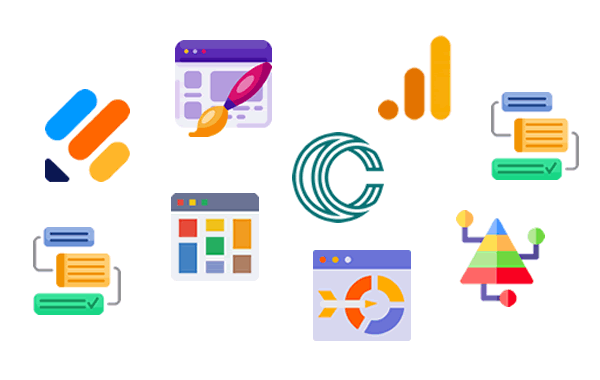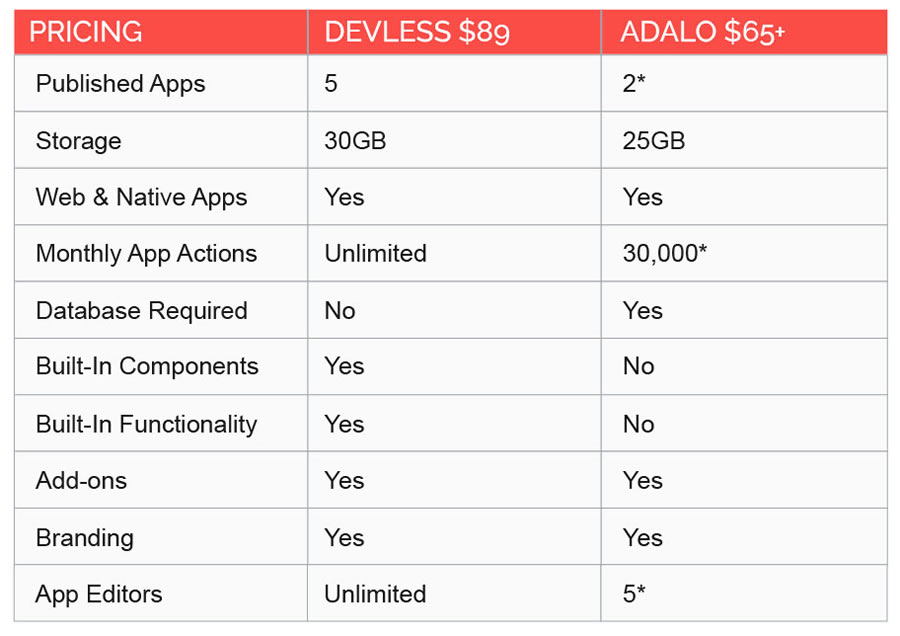Adalo vs Devless: Which No-Code Platform is Easier?
No-code platforms for app development are not created equal. It can be difficult to find one that’s right for your business and skill set.
Read on to learn 10 key differences between Devless and Adalo and which one simplifies the way users create mobile apps.


#1 Designing the UI: Save Time
Devless is a building software hyper-focused on ease of use. Devless apps have a sleek, modern user interface right out of the box with UI best practices already implemented. With an intuitive dashboard, users can quickly customize app layouts, icons, and colors simply by making selections from dropdowns, color pickers, etc.
Unlike Devless, Adalo uses a drag-and-drop interface. This type of editor is still better than having to write code, but this means you’ll spend a lot of time building out each screen – every button, list, form, etc. Whether creating simple or complex apps, you can expect design to take up a considerable amount of your time.
#2 Adding Components: Save Money
Devless app components are already built in which enables users to quickly bring their app idea to life. Users do not have to add, install, or pay for components. That fancy loading spinner is working from the moment you sign up, even on the free plan.
With Adalo, basic app components like buttons are included in their menu but others will need to be installed from the Adalo Marketplace. Most premium app components are an additional $15-$35 each. So, if you want a loading spinner for your app or a ‘confirm password’ field on a sign-up form, it’s going to cost you.
#3 Programming Functionality: Ditch the Database
Devless users get a fully functional app by adding resources and then using plugins to tell the app what to do with the resources instead of having to design and program functionality. Best of all for users, there is no database to manage.
On the other hand, after adding components in Adalo, you’ll need to program their functionality. Users must set up a database & create relationships so components display app content as expected. It can be tricky and is one of the biggest downsides according to users.
#4 Using Add-ons: Make it Effortless
Both no-code app builders offer attractive add-ons like Jotform that allow you to expand the functionality of your mobile apps. In Devless, you simply insert an API Key to start using forms and other tools.
In Adalo, you’d connect through Zapier so you’d want to track your zaps. Look to see which app builder provides the internal tools your business needs without overcomplicating your customers’ experience.

#5 Listing Native Apps: Take the Easy Route
Each app builder allows you to create a beautiful, responsive web app so you can reach any mobile device with a browser. However, many users also want their native mobile apps available for Android and iOS users in the Google Play Store and the Apple App Store.
While Devless helps list your native mobile app in the app stores, Adalo does not. Adalo does provide helpful documentation to help you get there or you can hire one of their experts to list your app directly.
#6 Scaling: A Warning about Monthly App Actions
The Devless app builder is a fixed price regardless of how many app actions end users take within your mobile applications. This means small businesses can scale without the worry of added costs.
Adalo’s pricing model counts certain Monthly App Actions completed by the end users of an app (switching screens, clicking links, logging in, etc). The added cost seems to prohibit some business owners from using this no-code platform beyond a proof of concept. App owners must pay $8 for every 15,000 actions over an account’s monthly limit.
#7 Inviting Team Members: Be Aware of Limit
Devless does not limit the number of admins, or team members, you can invite to help build apps. And whether building your own app or apps for clients, it’s easy to transfer ownership.
Adalo charges $15 monthly per additional App Editor beyond account limits, which vary per plan.

#8 Learning Curve: Leverage the Simplicity of Devless
Non-technical users seek a no-code app builder that makes mobile app development an intuitive process. Devless delivers the simplicity small business owners expect. If you need help, enjoy brief help docs and videos that are easy to digest.
The complexity of Adalo means there’s a steep learning curve if you don’t have technical knowledge. As a result, they provide plenty of documentation, videos, and even the Adalo App Academy. It has over 70+ courses to help users at every stage of building an app on their platform.
#9 Assessing Performance: What You Should Know
Business apps are expected to handle growth without performance issues and you can count on Devless to keep pace. Its architecture ensures your customers will have a fast, user-friendly experience.
Adalo’s web apps perform well too, but users have mentioned their native apps struggle with database connections and loading times. Adalo does have improvements in the pipeline, but it’s best to follow up before committing.
#10 Pricing Structure: Business Plan vs Professional Plan
While their approaches to building apps are very different, let’s see how the features of their recommended plans stack up. Here, we compare Devless’s Business Plan and Adalo’s Professional Plan.

*Adalo charges an additional $25 per app/mo, $15 per app editor/mo, and $8 per 15,000 monthly app actions.
Conclusion
Devless and Adalo are both great solutions. However, Devless is a better no-code tool considering its ease of use, especially if you’re building your first app.
Enjoy the peace of mind of not needing a developer and be worry free with its generous allowances that avoid unexpected costs. You’ll be able to focus on your creative ideas instead of a complex development process.
In today’s no-code movement, Devless strives to grant everyone access to simple software and empower a new generation of app creators. You can approach app building with confidence, have plenty of customization, and scale without worry!
